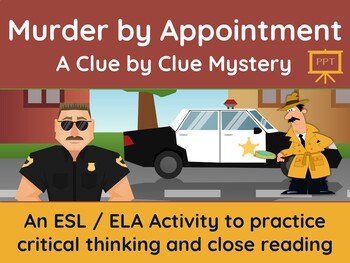Murder by Appointment: Critical Thinking Mystery PowerPoint Edition
- PPTX
Also included in
- Clue by Clues are mystery activities that help students practice critical thinking skills, reading strategies including close reading, critical reading, and inference, and get them discussing and talking! Students work in pairs or small groups to solve a mystery. They get a situation with a mystery.Price $75.00Original Price $105.00Save $30.00
Description
In this mystery activity that encourages discussion and critical thinking, a woman tells a rival CEO she will kill her at a specific time and day. The rival CEO is indeed found dead, but the alleged killer has the perfect alibi. She was across town at a party! How did she do it? Can your students use their reading strategies, critical thinking, and logical reasoning to analyze the evidence and figure it out?
The PowerPoint format makes it easy to share face-to-face in class, with large audiences, or in online classes. You can also easily import it in Google Slides and use it in Google Classroom!
You can also click here for the PDF Printable version of Murder by Appointment.
What is a Clue by Clue Mystery?
It's a great warm-up, critical thinking game, conversation starter, filler, or a time killer for early finishers. Students in pairs or small groups are given a mystery to solve—whodunit or how did they do it or why. They have to figure it out by reading a series of clues, one at a time. As they receive each clue, they speculate on its significance, what it tells them about the situation, and how it fits with the previous clues.
Once they have received all the clues, they have enough information to figure it out! This one will definitely get your students talking!
Inside find:
- Teacher Notes on how to use the clues, including suggested warm-ups.
- 11 clues, one per slide, to be shown to students one by one.
- Hints in the form of guiding questions to help students figure out what happened.
- The Solution: Students are not left hanging. The solution follows from the clues and students should be able to figure it out without any gimmicks or extra information beyond common sense.
Why Use Clue by Clues?
Clue by Clues encourage critical thinking and discussion. They are also close reading activities that teach students to look for details, synthesize information from different sources, apply prior knowledge about the world, and to recognize the logic of a claim and evaluate its validity.
While students are solving the mysteries, they are also developing their spoken language skills, using language such as:
- Modal verbs of speculation: She must have forgotten her keys, It could have been the butler
- Opinion language: I think...., I’m positive..., I’m not sure...
- Hedging: It’s possible, probably, maybe, it’s not impossible.
- Conclusions: That means that...
- Emphasis: There’s no way that...
- Hypotheticals: What if he didn’t do it, If he was at the movies, he couldn’t have done it.
They are also a lot of fun!
Enjoy this? Check out my entire Mystery Section with more clue by clues in different formats. I also have activities to help students write their own mysteries and more!
And please leave a review. It helps others find this resource and gives me valuable feedback when creating new ones!






